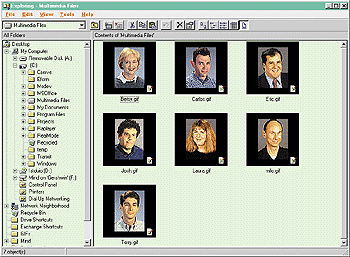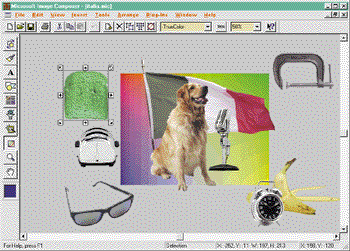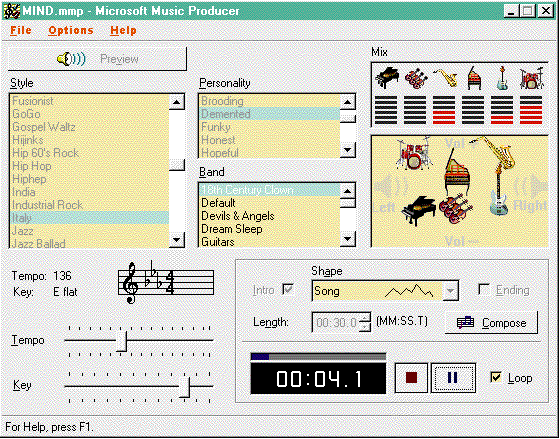
Now that images, sound, and other multimedia elements are becoming commonplace on the Web, Webmasters need tools to help them create, edit, and manage their media content. Microsoft® Visual InterDev™ provides three tools that address this need: Media Manager, Image Composer, and Music Producer. Media Manager is a utility that lets you create libraries for your online content so that you can easily search and retrieve items. Image Composer is a tool for arranging, customizing and creating onscreen images. And Music Producer allows you to produce original, royalty free music.
You don't need to be a creative professional to use these tools; they are simple and straightforward, and any user of Visual InterDev can quickly start using them to work with their media. At the same time, they're powerful enough to continue to satisfy growing needs.
Microsoft Media Manager is a utility that saves you time and makes you more productive by helping to organize your media content files and quickly search for specific items. Media Manager extends the Windows® user interface with a new kind of folder that resembles an artist's portfolio. You can work with these folders just as you would with any ordinary Windows folder: you can open them, drag files in and out, rename and move the folder itself, and create subfolders.
In addition to the standard folder views (large icons, small icons, list, details), Media Manager adds a new view: a thumbnail. Instead of telling you what your files are, Media Manager shows you right in the folder. You no longer need to open up your files to see if you have chosen the right one; you can simply browse through your folders right on your desktop. Media Manager provides visual thumbnails for a variety of image and video files; it also lets you preview your audio and video files simply by clicking on the thumbnail (see Figure 1). This feature can make your life much easier when the sheer number of files you own makes it difficult to manage ordinary folders.

Figure 1: Media Manager gives you a thumbnail view of a folder's contents
For many formats, Media Manager extends the set of properties available on files well beyond the basic Windows set, such as image size and color depth for pictures and videos, and time length for audio and video clips. It includes new pages in the Properties dialog for images, video, and audio, and standardizes those properties across a large variety of media formats. Media Manager will automatically extract the properties out of your files; you don't have to do anything. A list of supported file types and properties is available at http://www.microsoft.com/mediamanager/mmEvaluate/fileformats.htm.
Media Manager lets you add new properties to any file in a Media Manager folder. You decide what information is important to track in your own organization and keep it with your content files rather than in a separate database where it might get out of synchronization. For example, your company may need to track licensing or copyright information, or you might want to keep a list of the various places where a particular item has already been used. Properties that you add can be of a specific type; for example, a number, or a text string, or a date. You can even create your own central, shared list of property names to simplify adding them to your files.
Media Manager includes a powerful indexing and search engine for quickly finding the piece of content you are looking for. You can search for content either as a specific file
format or a class of formats such as images or video. You can also search for a file by its properties (both the ones that Media Manager automatically extracts from your files and the ones that you add yourself), or you can do a full-text search to find any occurrence of a word or words.
Media Manager isn't a separate interface to your files. Instead, Media Manager extends the familiar Windows user interface to include its powerful new features. You can keep doing everything you do in Windows today with the Windows Explorer and folders, and you'll barely notice that Media Manager is there. Media Manager also makes its services available through the standard Windows Open File and Save File dialogs, so its features will be available within all the applications you use to build Web content.
Microsoft Image Composer is an easy tool for helping you put professional-looking images on your Web site. You can take existing artwork, customize it, and make it Web-ready. You can also easily combine smaller images into larger composite pictures, allowing you to quickly reinvent your artwork for other uses.
Image Composer provides a new, more intuitive way of working with your images by letting you assemble larger pictures from smaller images called sprites. Any part of a sprite can be partially or completely transparent, which means that a sprite can have an irregular shape and represent just a foreground object with no background. To combine sprites, you simply lay out the sprites and layer them from front to back to overlap them.
The Image Composer workspace is a virtual drafting board for laying out your sprites (see Figure 2). The workspace can be as large as you want, and you can use it as a scratch space to keep your sprites handy even if you are not actively using them. You can reserve an area of your workspace as a composition guide to focus your efforts on creating an image of a specific size and exporting that image to your Web site.

Figure 2: Your workspace is a virtual drafting board
There are many ways to bring sprites into Image Composer. To start with, the product includes over 550 professionally prepared, royalty-free sprites from leading digital stock companies such as PhotoDisc. It also includes more than 150 Web-specific sprites, including buttons, bullets, and navigation bars that you can customize. You can also bring your own existing artwork into Image Composer; it reads all the popular image formats. Finally, the product supports the industry-standard TWAIN scanner interface, so you can scan images directly into Image Composer.
Image Composer has a wealth of tools for working with your sprites and tailoring them to your needs. You can rotate, flip, crop, and resize your images. You can paint directly on a sprite using a variety of brushes and techniques, and you can directly modify the transparency of any part of the sprite. You can apply over 500 visual effects to your sprites- textures, gradients, patterns, art effects, shadows and blurs, and a wide variety of other visual modifications that will give your images a polished, professional look. You can also use third-party effects you have purchased separately, such as Kai's Power Tools and KPT Convolver, directly within Image Composer.
You can create new sprites from existing ones by selecting and extracting regions of any shape-this is a very powerful way to pull out pieces of larger pictures, such as a person or an object.
You can save your images as native Image Composer files with all the rich sprite information intact so you can edit and repurpose them later. However, Image Composer also makes it easy to write out images in Web-standard formats such as GIF and JPEG. You can select one or more sprites in your workspace and export them to GIF or JPEG files with a single command. Or you can take advantage of the composition guide to speed the process-when you export your entire composition, Image Composer will flatten all of the sprites into a single image, crop your image just to the part within the composition guide, and then save that part.
Music adds a whole new dimension to your Web site, making it a more engaging experience for your readers. But adding music can also be a troublesome and expensive endeavor; in the past, a Web site author would need to either use stock music or hire someone to compose and perform a new piece of music. In either case, the author would need to pay for the rights to use that music on a public Web site.
Enter Music Producer: this easy-to-use tool helps you create an original musical composition, and you can use your opus on your Web site without paying any royalties.
Music Producer lets you choose from more than 100 different styles of music, including classical, jazz, rock, country, various regional styles, and some entertainment-specific (such as "chase" or "adventure" music you'd expect in an action movie). You can choose a specific band of instruments to perform the composition, and you can adjust the tempo and key of the music to match the other audio components of your site. You can specify the length of your composition to one-tenth of a second, and you can control the overall "shape" of the music to give it a feeling of progression through various complexities and moods (see Figure 3).

Figure 3: Make your own music
Once you have filled in the specifications, Music Producer will generate a new, original piece of music. You can create as many compositions as you need based on the same specifications, and each of them will be randomly unique, yet still similar to the others. Music Producer will save each composition as a MIDI file, which you can then use as background music on a Web page or play using an ActiveX™ component.
With Media Manager, Image Composer, and Music Producer, you can jump into the world of multimedia content and start rolling out more attractive and compelling Web sites. You don't need a degree in fine art to use these tools, and that's the whole point. Put the tools to work for you and you should start to see improvements in your Web sites right away.